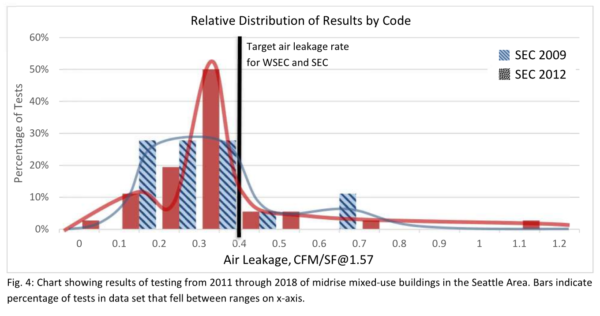February TAC Event: Lessons from Building Air Leakage Testing in Seattle
Details
Date:
Category:
- TAC
Online registration has closed.

What We’ve Learned and Where We Go From Here
As building codes both within the U.S. and across the globe increasingly are focusing on building airtightness as a fundamental piece of the larger sustainable-built-environment strategy. Join us to hear our speakers share their decade of experience with air barriers in the greater Seattle, WA area.
The City of Seattle has logged more than 8 years with a code requirement to quantitatively demonstrate whole-building airtightness performance through a building air leakage test. When introduced in 2009, this requirement was unique among codes in the US and has since set Seattle apart from other jurisdictions. While initially met with skepticism by some, whole building air leakage testing is now common practice for large buildings in Seattle and across much of Washington State.
The adoption of this new code requirement was not perfect. There were growing pains and lessons learned and now that other jurisdictions move towards airtightness, it is more important than ever to share these lessons. We will review aggregate data from test results collected over the past 8 years and discuss their implications for both design and construction. We will also explore some market-side anxieties that designers and builders should expect when such a requirement is adopted and how these anxieties can be addressed. Finally, we will discuss some practical limitations to testing – particularly as buildings get bigger and taller and explore real-world case studies of what works and what doesn’t. While scary at first, building air leakage testing can be a valuable tool for various stakeholders (including owners, developers, architects, contractors, and consultants) and can help push our industry forward.
Learning Objectives
Upon completion of this program, participants will be able to:
- Avoid common misconceptions by identifying how the air barrier fits into the larger picture of building science and how it forms a basis for energy-efficient enclosure design
- Achieve energy efficiency and environmental quality targets by implementing enclosure design approaches that are more likely to result in an airtight enclosure and avoid design approaches that are more likely to be leaky.
- Illustrate the practical limitations to building air leakage testing
- Recognize what to look out for when air testing your own large buildings to validate mandated performance requirements in sustainable building codes for energy efficiency and environmental quality.
About the Speakers
Jose Estrada, PE is a senior building science specialist with JRS based in Seattle. With over a decade of consulting experience, Jose has provided technical consultations on all types of projects, ranging from low-rise residential buildings to multi-billion dollar high rise Type A office projects. His experience also spans borders, having worked on projects in the US, Canada, Mexico, and across China.
Brad Carmichael, PE, Assoc. AIA is a senior building science specialist with JRS, also based in Seattle. With over a dozen years of consulting experience, Brad has provided technical consulting on projects of all types and sizes, ranging from historic preservation of monumental buildings to multi-billion dollar, new construction, full block high-rise developments. His experience includes projects on the US east and west coast and in Mexico. Brad is also an active member with ASHRAE.
Both Jose and Brad share experience with whole building airtightness testing and design/implementation of building air barrier systems. When not working on projects, both Jose and Brad enjoy writing industry articles and speaking publicly about different emerging building science topics.
Online registration has closed.

